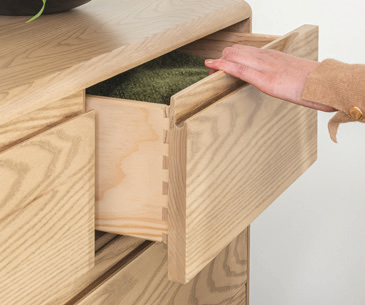Whether your furniture is solid or veneered, it needs some TLC.
Find out what finish has been applied to your furniture. Most wooden furniture manufactured today has been sprayed with more than one layer of clear lacquer which gives the timber some protection from moisture, but not usually from excessive heat. The gloss level can vary, from matte to high-gloss. It is able to withstand gentle cleaning as long as you use minimal moisture. Don’t soak the wood or leave wet spills on the surface. If it is badly damaged, it will need to be repaired by a professional.
If the furniture has had an oil or wax finish, this can be maintained using a similar product, and will require regular maintenance.
Dust regularly – but don‘t use a silicone-based spray such as Pledge, which builds up on the surface. Those rings that appear where your coffee cup sat are most likely showing up in this build-up, and not on the finish applied in the factory.
Wipe with a soft cloth, which can be slightly damp. You can use a small amount of diluted mild liquid detergent to remove oily or greasy stains – make sure you dry the surface afterward with a soft cloth.
Polish – or not? Most of the time, it is not necessary to put any sort of polish on your furniture. If the surface starts to look a bit dull, or you want to fill tiny surface scratches that happen with everyday use, we recommend a product such as Mirotone Spray Glow (available in store), which is made with natural oils and waxes, and is silicone-free.
Oil or wax – these won’t penetrate a surface which has been lacquered, but they can add an extra layer of protection. if you want a higher sheen, then they work just like shoe polish – the more you rub, the glossier the surface will become.
Direct sunlight, or even indirect exposure to the strong UV rays of the Southern Hemisphere sun will discolour wooden furniture. You may not notice this as it can be gradual, but over time, most timber will darken, or yellow. This is a natural process, and not a fault of the protective coating, or of the timber. Be careful about leaving something permanently on a table or cabinet top, and close curtains and blinds where necessary.
Humidity can cause big problems. Sadly, our very changeable climate is not a good friend to solid timber, and is often a sound reason to choose a good quality veneered piece over solid timber. A very dry environment can cause wood to shrink as it loses moisture, and a very damp environment can cause swelling. Rapid change can cause cracking, splitting and warping. If possible, keep furniture well away from a strong heat source such as a wood burner or heat pump,
Liquids can cause damage, so coasters, placemats or table runners can be a good way to protect the surface. Be careful about putting hot or cold items directly on to a timber top – use a heat-proof mat to prevent burning, or ‘blooming’ which can occur with a cold item. If you catch this happening you may be able to rub out cloudiness using a soft cloth.


Leave a comment